
Jan Borman (sometimes Borreman or Borremans, fl. c. 1479-1520) was a Flemish Northern renaissance sculptor.

Jan Borman (sometimes Borreman or Borremans, fl. c. 1479-1520) was a Flemish Northern renaissance sculptor.
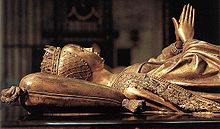
Borman belonged to a family of sculptors. His father was also a sculptor and the two seem to have worked together on at least one occasion. Jan Borman is mentioned for the first time in 1479, when he joined the guild of sculptors in Brussels. In 1484-86, he received a commission to supply statues for one of the side-altars in Antwerp Cathedral. In 1491, in connection with a commission to restore and create new sculptures for Sint-Jacobskerk (Church of St. James) in Leuven, Borman is reported to have entered the joiner's guild of Leuven. In the same year, he was probably responsible for making the wooden model for the bronze tomb of Mary of Burgundy in the Church of Our Lady in Bruges. A few years later, he is recorded having received payment for a crucifix for the Church of St. Sulpitius in Diest. [1]
Borman made a large, signed and dated altarpiece dedicated to St. George for the Guild of Crossbowmen in Leuven in 1493, today housed in the Art & History Museum, Brussels. [1] It has been described as Jan Borman's most famous work. [2]
With time, Borman became a highly regarded artist. In 1511 he was commissioned to make wooden models and other sculptures for the tombs of the Duke and Duchess of Brabant. In the same year, he is described in royal accounts as "the best sculptor". He received further prestigious commissions and official accounts imply that he may have been at some stage employed by the city of Brussels. [1]
Jan Borman had two sons, named Jan and Passchier, who also were sculptors and who occasionally collaborated with their father. [1]
Borman's style has been described, in connection with his famous 1493 altarpiece, as characterised by
"[...] meticulously carved decorative details of costume, hair and beards, [and an] agile, exaggerated sense of movement using twisting and swaying poses, the slender figures often placed with their backs to the viewer and swathed in heavy, angular, folded drapery."
— Gordon Campbell (ed.), The Grove Encyclopedia of Northern Renaissance Art
Several altarpieces have been attributed to Jan Borman, apart from the ones already mentioned. The large number and the uneven quality of the work imply that his name indicates a whole workshop rather than an individual master. A large number of altarpieces by Borman can be found in Sweden, where Strängnäs, Uppsala and Västerås cathedrals all have altarpieces attributed to his workshop. In addition, there are altarpieces in Vadstena Abbey and a number of smaller Swedish churches, e.g. Jäder, Skepptuna, Bro and Ytterselö. Other works are found in the Church of St. Nicholas in Orsoy, Germany and in the church in Boendael, Belgium, [1] as well as in the Art Museum of Estonia (Tallinn). [3]
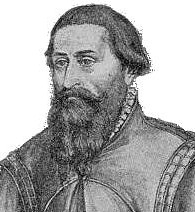
Veit Stoss was a leading German sculptor, mostly working with wood, whose career covered the transition between the late Gothic and the Northern Renaissance. His style emphasized pathos and emotion, helped by his virtuoso carving of billowing drapery; it has been called "late Gothic Baroque". He had a large workshop, and in addition to his own works there are a number by pupils. He is best known for the altarpiece in St. Mary's Basilica in Kraków, Poland.

An altarpiece is an artwork such as a painting, sculpture or relief representing a religious subject made for placing at the back of or behind the altar of a Christian church. Though most commonly used for a single work of art such as a painting or sculpture, or a set of them, the word can also be used of the whole ensemble behind an altar, otherwise known as a reredos, including what is often an elaborate frame for the central image or images. Altarpieces were one of the most important products of Christian art especially from the late Middle Ages to the era of the Counter-Reformation.
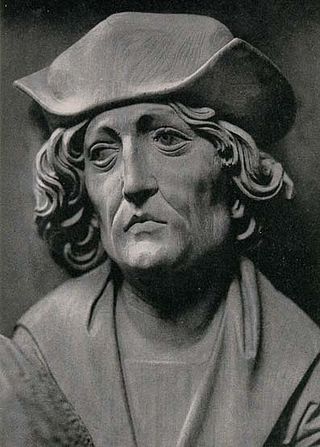
Tilman Riemenschneider was a German sculptor and woodcarver active in Würzburg from 1483. He was one of the most prolific and versatile sculptors of the transition period between late Gothic and Renaissance, a master in stone and limewood.
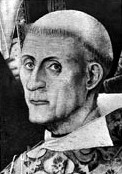
Bernt Notke was a late Gothic artist from the Baltic region. He has been described as one of the foremost artists of his time in northern Europe.
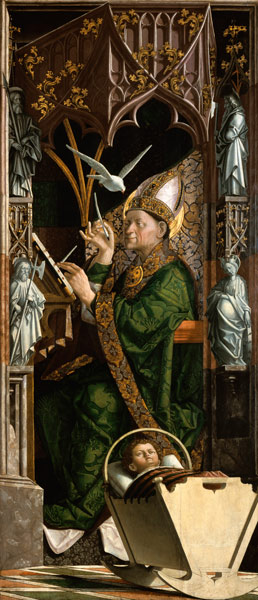
Michael Pacher was a painter and sculptor from Tyrol active during the second half of the fifteenth century. He was one of the earliest artists to introduce the principles of Renaissance painting into Germany. Pacher was a comprehensive artist with a broad range of sculpting, painting, and architecture skills producing works of complex wood and stone. He painted structures for altarpieces on a scale unparalleled in North European art.
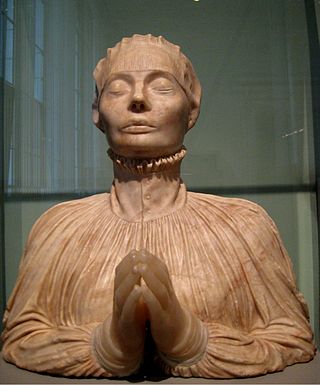
Cornelis Floris or Cornelis (II) Floris De Vriendt was a Flemish sculptor, architect, draughtsman, medallist and designer of prints and luxury. He operated a large workshop in Antwerp from which he worked on many large construction projects in Flanders, Germany and Denmark. He was one of the designers of the Antwerp City Hall. He developed a new style, which was informed by Flemish traditions, the 16th century Italian renaissance and possibly the School of Fontainebleau. His innovations spread throughout Northern Europe where they had a major influence on the development of sculpture and architecture in the 16th and early 17th centuries.

Saint Peter's Church in Leuven, Belgium, is a Roman Catholic church built in the 15th century in the Brabantine Gothic style. The church has a cruciform floor plan and a low bell tower that has never been completed. It is 93 metres (305 ft) long. It is located on the city's 'Grote Markt', opposite the Town Hall. In 1999, the belfry and bell tower of the church was inscribed on the UNESCO World Heritage List as part of the Belfries of Belgium and France site, in recognition of the civil importance and architecture of the belfries in the region.

Lucas Faydherbe was a Flemish sculptor and architect who played a major role in the development of the High Baroque in the Southern Netherlands.

St. Nicholas Church is a medieval church building in Tallinn (Reval), Estonia. It was dedicated to Saint Nicholas, the patron of the fishermen and sailors. Originally built in the 13th century, it was partially destroyed in the Soviet bombing of Tallinn in World War II. The building itself has since been restored; however, as a church without own congregation, it has not been used for regular religious activities since World War II. At present it houses the Niguliste Museum, a branch of the Art Museum of Estonia, focusing mainly on ecclesiastical art from the Middle Ages onward. It is also used as a concert hall.
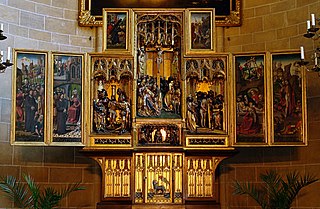
Jan Van Wavere was an influential Brabantine polychromer of late gothic Brabantine altarpieces, mainly produced in the Brabantine towns of Antwerp, Brussels and Mechelen. During the 15th–16th century, over 1000 altarpieces were traded and exported to many European countries. More than 300 complete examples of Brabantine altarpieces can still be found in museums and churches all over Europe, from the Baltic countries down to Spain.

Damià Forment was a Valencian Spanish architect and sculptor, considered the most important Spanish sculptor of the 16th century.

Colijn de Coter was an early Netherlandish painter who produced mainly altarpieces. He worked primarily in Brussels and Antwerp. His name was sometimes given as Colijn van Brusele, indicating that he hailed from Brussels or at least that he lived there most of his active life. He also signed several paintings with Coliin de Coter pinxit me in Brabancia Bruselle.

Hendrik Frans Verbrugghen or Hendrik Frans Verbruggen was a Flemish sculptor and draftsman, who is best known for his Baroque church furniture in various Belgian churches.

Skepptuna Church is a medieval Lutheran church in the Archdiocese of Uppsala in Stockholm County, Sweden.
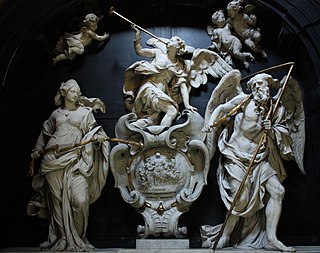
Mattheus van Beveren was a Flemish sculptor and medalist who is mainly known for his monumental Baroque church sculptures and small wood and ivory sculptures. He also made medals and die designs for the Antwerp Mint.

Artus Quellinus II or Artus Quellinus the Younger was a Flemish sculptor who played an important role in the evolution of Northern-European sculpture from High Baroque to Late Baroque.

Adriaen van Overbeke, Adrian van Overbeck and Adriaen van Overbeke was a Flemish Renaissance painter in the style of Antwerp Mannerism. He operated a large workshop with an important output of altarpieces, which were mainly exported to Northern France, the Rhineland and Westphalia. His known works were predominantly polychromed wooden altarpieces with painted shutters, which were created through a collaboration between painters and sculptors.
The triumphal cross in the Saint Peter's church in Leuven was made between 1490 and 1500 by, presumably, the workshop of the Brussels sculptor Jan Borman. It is even suspected that the figures of Christ, John and Mary were made by the master himself. The chapel in which the triumphal cross is located is the oldest preserved in Leuven, with various but unconfirmed attributions concerning authorship, including Matthijs de Layens, Jan II Borreman, Jan de Messemaker, Hendrik van Evergem.

Kort Rogge, also known as Rogge Kyle, Konrad Rogge, Cort Rogge, Conradus Roggo gothus and Conradus Roggo de Holmis, was a Swedish bishop, member of the Privy Council of Sweden, and humanist.

Jan Frans Boeckstuyns, Boekstuijns or Boecxstuyns was a Flemish sculptor and architect who spent most of his active career in his native city Mechelen. He was also active as a manufacturer of gilded leather. While he mainly created church furniture and decorations, he also produced a number of small-scale works, including crucifixes and terracotta figures. He further designed architectural elements of buildings. His works show a transition from the high Baroque towards a more realistic and decorative style closer to the Rococo.